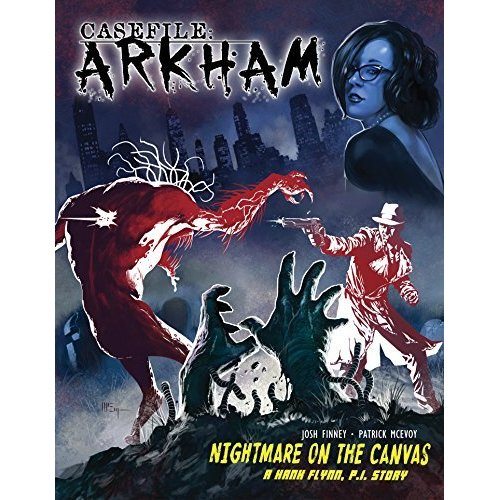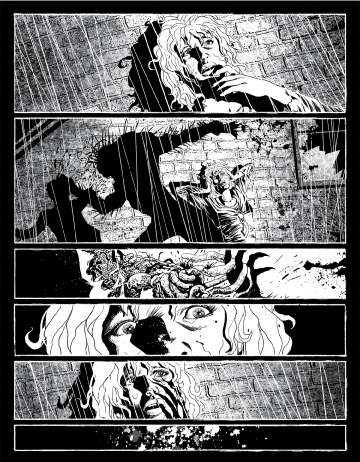
Hellnotes (HN): Where did the idea for Nightmare on the Canvas come from?
Josh Finney (JF): Where’d it come from? A little bit of Lovecraft, a little bit of Chandler, and a whole lot of love for classic noir. Due to Patrick’s extensive work with various Lovecraft gaming properties, we’d had several fan requests for us to do something in Lovecraft’s universe. Initially we’d talked of doing a straight adaptation of “Pickman’s Model,” but soon realized the story suffered from the same problem that most of Lovecraft tales do—his protagonists are extremely passive. His characters tend to allow the story happen to them, rather than being active participants. Neither Patrick nor I were all that interested in spending the next nine months of our lives with that story character. Which leads right in to your next question…
HN: Why blend crime noir with Lovecraft?
JF: Because someone needed to punch Richard Upton Pickman in the face. The great thing about the detective noir genre is the hero tends to 1) Inhabit a moral gray area, 2) Be completely damaged, and 3) actively place himself in the middle of the action…and punching antagonists in the face.
Again, Patrick and I are aficionados of classic noir and have been wanting to do a hardboiled PI story with a supernatural undercurrent. In many ways Lovecraft’s work and the stories of Chandler came from the same place—a postwar America struggling with the moral, spiritual, and economic uncertainties of being forced to peer into the dark places they fear most—which is often themselves. The difference being in noir characters grit their teeth and go down fighting…well, that, and they’re turned on by strong (and dangerous) women. Whereas Lovecraft was terrified of them.
Patrick McEvoy (PM): In a way it came out of an early discussion we had about what sort of book we were doing. We’d discussed how doing a Lovecraft story would be fun, but his protagonists were annoyingly fragile, poised to faint at the first sign of unearthly horrors. At the same time, Josh and I shared a love of the classic noir and hardboiled detective genres, and the idea to combine the two quickly morphed.
We’d both seen most of the very few films and comics done in this genre, and in our opinion none really had the blend of noir and horror story elements we would have wanted. Either they messed too much with the heart of what makes noir great, or, often, they veered into self-parody. In my mind, [the movie] Angel/Heart probably comes closest in tone, but it’s a rare bird. And being contemporary, it didn’t have the cool outfits and cars of a 1940’s detective story!
HN: Why did you choose to do the graphic novel entirely in black and white?
PM: Film Noir is at home in black & white (few standouts like Chinatown notwithstanding), so that was a natural. Also, I wanted the art to be reminiscent of the classic Warren horror comics, and also my favorite strip artist of the era we were working in (the late 1940’s), Alex Raymond. I also added elements from German Expressionist film, another classic B&W genre. It all came together in a way that demanded the purity of solid blacks
JF: I’m a firm believer in the art style fitting the narrative. This is classic noir, which has its visual roots in German expressionism. This story could not be told in anything but black & white. Color would’ve killed it.

JF: It was largely collaborative. The back and forth between Patrick and I was critical to the final result.
PM: We settled on using the classic Lovecraft story “Pickman’s Model” as a framework, and created the main characters and world, before we started. At that point I began working on the art style, as it was a look I’d never done before. While I was doing that, Josh was busily crafting a classic noir story and fleshing out the characters.
I should add that we already knew each others storytelling and work habits pretty well from our time doing World War Kaiju, our first graphic novel together. So the teamwork was already well on its way.
Since it was such a monster-scale project, Josh began sending script pages in small chunks so I could get started. This allowed us to continue making tweaks to the story as it progressed, teasing out themes and character details. We used the best of both “traditional” and “Marvel-method” scripting, as Josh would give me ideas of script and action, often rough but usually with some page layout ideas, and I’d send back a completed page that he could then write final dialog over.
We got to the point that Josh was able to write notes in several places such as “random panel here” and he’d just let me do whatever I thought would add to the mood or story at that point. Little tricks like that kept the storytelling both densely-packed and exciting, I think. It’s anything but “decompressed”!
HN: Any future Casefile: ARKHAM tales on the way? Any hints as to which Lovecraft stories you’d like to tackle?
PM: Funny you should ask! We have a Kickstarter coming up VERY soon for book two: “Her Blood Ran Cold”. I’ll let Josh tell you all about it:
JF: Is there a future for Casefile: ARKHAM? Yes! We’ll be launching a Kickstarter for Hank Flynn’s next dark dive into the Lovecraftian underworld very soon. Titled, “Her Blood Runs Cold” this second story will delve more into both Flynn and Glynda’s past, as well as the scaly underbelly of Innsmouth’s blue bloods. And yes, that does mean more gun toting visits from the Innsmouth mob.
As for future? There are plenty of cases waiting to Hank Flynn if opportunity allows. The Shadow Over Innsmouth is probably at the top of our list. We’ve also discussed possible plots involving From Beyond, The Music Eric Zahn, and Nyarlathotep. And I would love to someday do The Shadow Out of Time as a Hank Flynn case.
Just don’t expect Flynn to encounter any tentacle-faced gods anytime soon.
HN: As fans of H.P. Lovecraft, what are your favourite stories by him?
PM: For me, it has to be The Colour out of Space, The Music of Erich Zann, The Rats in the Walls, The Call of Cthulhu, and of course, Pickman’s Model. Yes, it’s hard to narrow down!
JF: That’s hard to say. Sometime the stories with his best ideas are written in the most impenetrable of prose, like Dreams in the Witch House. The mythos itself is Lovecraft’s strength. That said, I have a real appreciation for The Shadow Out of Time. I also quite enjoy The Whisperer in the Dark as it seems to have informed so much our own modern gray alien folklore.
HN: What are your favourite graphic novels/artists? Have they inspired the way you create?
JF: Dormant Beast by Enki Belal
Glimmer Rats by Gordon Rennie & Mark Harrison
Grendel Tales: Devils & Death by Macan & Biukovik
The Coffin by Phil Hester
Blame! by Tsutomu Nihei
Durham Red: The Scarlett Cantos by Dan Abnett & Mark Harrison
The Max by Sam Kieth
PM: Specifically for this project, I’d have to say the biggest influences were the afore-mentioned Alex Raymond – especially his Rip Kirby strip – and Al Williamson, from his E.C and Warren work, and also the Secret Agent Corrigan strip from the ’60s/’70s. Anyone who’s interested can find great fantastic collections of those strips from IDW. They’re well worth the investment.
And I should mention Will Eisner’s The Spirit, too. Aside from being a great time-capsule of the 1940’s, the storytelling and composition remains as brilliant and groundbreaking today as ever.

JF: Don’t trust anyone who says graphic novels are “just movies on paper.” Sequential art is a unique form of storytelling with its own strengths and weaknesses. There are things the medium is capable of that cannot be replicated in prose or film. Study it. Know it. Exploit it to the fullest.
PM: You can find art tips everywhere, so seek them out and draw all the time. Never be shy about copying pictures for practice. That, and drawing from life, are the best ways to get better as an artist.
But here’s the important part: don’t just worry about the individual drawings. As a comics artist, you need to worry just as much or more about telling a story. Study the way your favorite creators actually move you through the story, using composition, panel placement, lighting, acting, “camera” position and angles, and everything else. The pretty pictures are just the start; it all has to come together to create a successful book.
HN: Some writers have a space, like a writing room in their home, where their creativity flows. Do you have a space like that? What sort of items do you keep in it to inspire you?
PM: I’ve had an office/studio room in the very place I’ve lived for some time now. If at all possible, I recommend a room of your own to create in. As such, I’ve got everything! Desk, drawing table, easel, file cabinet, boxes of toys/reference, and big shelves full of books, books, books!
JF: My method is total immersion. During a project I will eat, sleep, and breathe the subject matter until completion. While on Casefile: ARKHAM, my viewing and reading habits remained firmly planted in the golden age of noir, a time period which fell roughly between 1930 to 1955. I watched all the noir films I could get my hands on—both good and bad. I read a whole hell of a lot of Raymond Chandler. I would actually sleep to the BBC’s audio drama adaptions of his Marlow stories. Another big part of my process is music. Inevitably a collection of songs and albums will begin to form a soundtrack for whatever I’m working on. Movies scores come into play quite a lot. If I’m able to associate a mood or headspace to a song or songs, listening can snap me back to where I need to be to write a scene. My Casefile: ARKHAM playlist consisted of the soundtracks to LA Noir and Chinatown. When writing the more horrific scenes I listened to a lot of black ambient / industrial ambient. Artists such as Lustmord, Vestigial, and Atrium Carceri.
HN: Lastly, can you tell us about any other projects you may be working on?
PM: It can’t be mentioned enough: Casefile: ARKHAM book 2 is going to be real, but only if we get everyone’s support on Kickstarter. So please take a look at that!
Also, I’m drawing, coloring and doing covers for Lost in Space: The Lost Episodes from American Gothic Press. I was doing covers and coloring only for issues 1 – 3, but starting with the second story arc in issue #4, I’ll be doing it all! Look for that this month (August), then continuing the story in #5 and #6.
JF: What’s next is more Casefile: ARKHAM. In 2017 Hank Flynn will be back in, “Her Blood Runs Cold.”








